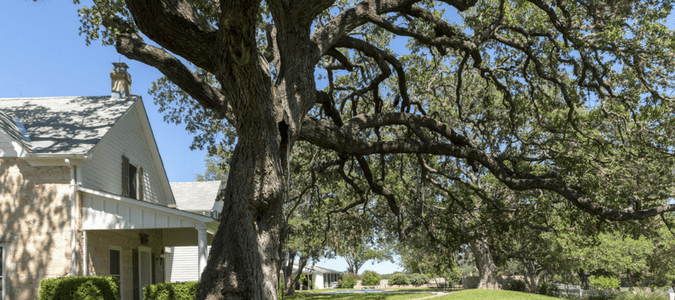
Trees add to the aesthetics of your property, help reduce energy costs and improve your home’s value. But which trees are, in fact, best suited for the extreme heat and dry conditions we often experience here in Texas?
Many homeowners aren’t sure which types of trees have adapted to our climate. They may also not realize that planting these species on your property can reduce your water bills, decrease the time you spend on maintenance and lower the risk of a tree’s limbs falling because of stress from drought. Keep reading to learn more about Texas native trees, the fastest growing shade trees in Texas, Texas evergreen trees, Texas flowering trees and the most common trees in Texas.
Texas Native Trees: Low Maintenance Additions To Your Landscape
A recent study reported that about 90% of the trees found in Austin are native. The survey put the final tally of the number of trees in Austin at almost 34 million. These towering plants capture almost two million tons of carbon dioxide each year across our area. A few of the more well-known natives that are found in Central Texas are the live oak, cedar elm, Spanish oak, Texas ash and the black cherry.
Live Oak
Live oaks, also known as Quercus virginiana, are the most commonly planted native trees in Texas. Chances are, you might already have one in your front or back yard. There are a few species, but the more common types are the escarpment and interior live oaks. Native to the area north of the Gulf Coast almost to the Red River, these massive trees grow to be 35 or 40 feet tall and, sometimes, more than 75 feet wide. The escarpment live oak is best suited for shallow soil, as it is more drought tolerant, and prunes only during the hottest and coldest months. Under the right conditions, these trees can live for more than 100 years, with some local trees surviving up to 500. Homeowners should consider both the size and longevity of these giant trees when considering whether to add one to your property.
Cedar Elm
Cedar elms, which have the scientific name of Ulmus crassifolia, are second in popularity to the live oak tree in Texas. Compared to other elm species, the cedar elm is recognized for its smaller leaves and thicker cuticles, which help these plants survive in hot, dry climates. Similar to live oak trees, this species can live up to 100 years or more under ideal conditions. The cedar elm can reach anywhere from 50 to 90 feet high when mature and can tolerate poor drainage, compacted soil and urban air pollution. For these reasons, cedar elms are considered low maintenance and often used in parking lots and other areas where shade is at a premium. The only downside of this species is that drooping branches can cause major limbs to break and fall. To avoid this happening, homeowners should keep these large branches so they are no longer than about two-thirds the size of the diameter of the trunk. In addition, cedar elms are vulnerable to powdery mildew, Dutch elm disease and becoming infected with mistletoe, which can ultimately lead to tree death.
Southern Red (Spanish) Oaks
Like the live oak and cedar elm, the southern red oak can live well over 100 years. Unlike this oak’s counterparts, however, the Quercus falcata and Quercus buckleyi southern red varieties are typically found on rocky ridges and slopes and in areas where the trees have shaded root zones. This species, which is considered medium to large in size, can also be found in greenbelts. Because of this tree’s inability to retain large amounts of water, planting them where few other plants or trees will grow is ideal. Many different types of wildlife enjoy the acorns of these species. The trees provide homeowners with yellow and red foliage during the fall.
Texas Ash
Unlike the other native trees we’ve already mentioned, the Texas ash (also known as the mountain ash or by its scientific name, Fraxinus albicans) has a relatively short life, typically lasting between 15 and 20 years, and sometimes less. The Texas ash is also considered a small tree, growing to a height of between 35 and 40 feet. Leaves do change to brilliant colors during the fall months. You can extend the life of a Texas ash life by planting it in deeper soils with irrigation and be applying fertilizer three times a year. This tree species can also attract birds and butterflies.
Black Cherry
Native to eastern North America, the black cherry tree is native in areas from east to west Texas. The Prunus serotina grows relatively fast and has fragrant white flowers that attract a variety of species, including the Eastern tiger swallowtail and several types of bees, and fruit, which attracts birds. Known for quality wood which is often used to make furniture, toys and paneling, the black cherry is easy to grow. A black cherry’s leaves will turn yellow in the fall months and the fruit will darken. This upright native Texas tree prefers well-drained limestone and does better in moist areas where the alkaline in the soil is more moderate. Under ideal conditions, this tree typically doesn’t grow taller than 50 feet or wider than 35 feet, making it ideal to include in yards.
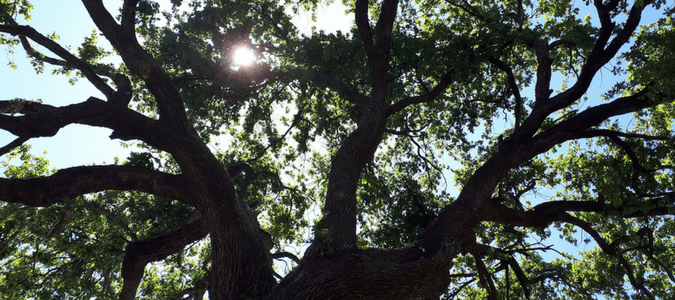
Fastest Growing Shade Trees in Texas
Texans are always on the lookout for shade, especially during the summer months. A few types of trees which can give you a welcome break from the sun include white oaks, Shumard’s Oak, Texas ash, American sycamore and the American elm.
Mexican White Oak
Also known as the netleaf white oak or Monterrey oak, the Quercus polymorpha can grow as wide as 60 feet and a high as 80 feet. This species is resistant to oak wilt, in addition to other diseases and pests that typically affect other oaks; it is classified as a hardy evergreen oak tree. This tree is widespread in Mexico (hence its name), and is becoming a much more common addition to urban landscapes.
Shumard Oak
Quercus shumardii is a pyramid-shaped tree with brilliant orange to deep red leaves in the fall. This hardy tree grows to be between 50 and 90 feet tall with bark that is thick, smooth, and grayish. These oaks can grow in a variety of soil types, including sandy, clay, limestone-based or caliche, but prefers deeper soils. A Shumard oak is a relatively fast-growing, adaptable tree that is relatively drought-resistant and can tolerate short-term flooding. One downside of this type of tree is that in certain parts of Texas, oak wilt is a relatively common and potentially deadly affliction.
Texas Ash
Not only is the Texas ash a native species, but also it can quickly grow to provide your yard with some nice shade. This medium sized tree prefers salty soil that is loamy and well-drained. The Texas ash can tolerate dry soils as well. Water needs are moderate, and this species has a long life, with yellow, orange and purple leaves during the fall. Homeowners should monitor these trees for aphid infestations, fertilize three times a year and regularly prune to remove dead growth.
American Sycamore
This wide-canopied, deciduous tree with the scientific name Plantus occidentalis grows to be 75 to 100 feet tall and has an open crown and a large trunk. The sycamore trunk’s diameter grows larger than any other native hardwood. Though this species can tolerate moist, sandy loams or silty clays, moist soils are preferred for optimal growth.
American Elm
This well-known species, also known as the common elm and soft elm, typically grows between 60 and 80 feet high. The vase-shaped trunk of the Ulmus americana divides into several erect limbs that are recognizable on front lawns and streets. The American elm prefers full sun well-drained soils and can tolerate high heat. One potential problem to note, however, is this species’ susceptibility to Dutch elm disease.
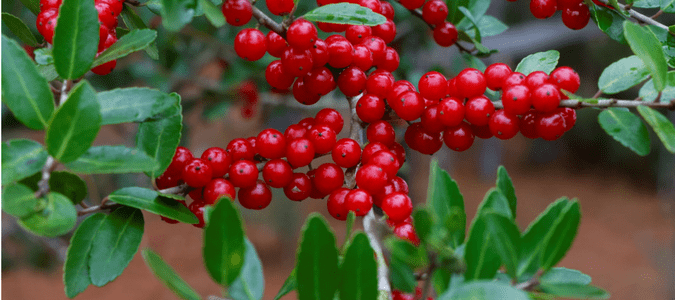
Texas Evergreen Trees
Unlike deciduous trees, which drop their leaves, evergreen trees lose their leaves gradually, keeping a consistent canopy year-round. This distinction means that evergreen trees are even more valuable on your property, as they provide your property with year-round protection from the Texas heat, which can help keep your utility bills lower. If you are considering adding one of these trees to your yard, we recommend the Japanese blueberry, weeping fig or yaupon holly.
Anacua
The Anacua tree, also known as the anaqua tree, the knockaway tree, the sandpaper tree and Ehretia anacua, grows well along streams and sandy deposits, but has also been known to thrive in alkaline soils. This tree has simple wide, oval leaves that feel like sandpaper on top. Anacua trees produce small, white flowers from late fall to early spring, which can attract quite a few bees. These trees grow to be between 30 and 50 feet tall with trunks up to two feet in diameter. A very low maintenance tree, the anacua doesn’t require much watering and can tolerate lots of sun.
Eastern Red Cedar
This tree, Juniperus virginia, is one of the most widely distributed conifers in America. Eastern Red Cedars are great for Texas homes, because they are extremely tolerant of drought conditions and heat. The leaves on this species are usually dark green. In the early spring, the tree grows cone shaped berries. Eastern red cedars can grow up to 90 feet tall, but are usually between 30 and 40 feet. These trees attract birds and butterflies and prefer full sun.
Yaupon
Yaupon holly trees are popular in Texas yards because they can thrive under a wide variety of conditions. Although they do require pruning, Ilex vomitoria have attractive red berries which are a favorite for visiting wildlife. Yaupon trees prefer some shade and can do well in poor drainage areas, as well as having a high drought tolerance. These trees are usually taller than 10 feet, but they normally don’t grow more than 25 feet. In residential areas, these trees can even be trimmed to be hedges.
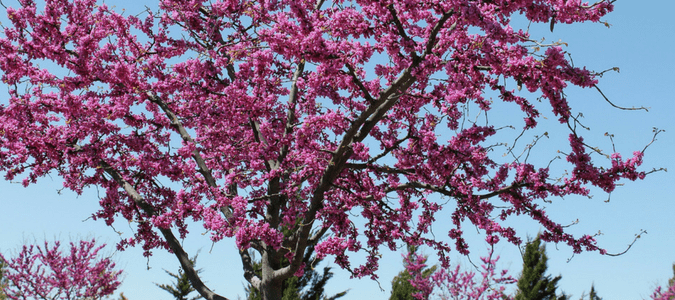
Texas Flowering Trees
Flowering trees can add extra color to your lawn. The first species many of us think of when we think of flowering trees is the mountain laurel, but you have other options. A few trees that can achieve this visual impact are redbuds, crape myrtles, desert willows, vitex trees and magnolias.
Redbud
For those particular to pink and purple blooms, the Texas redbud tree (Cercis canadensis var. texensis) is a great bet. This tree can withstand drought and dry temperatures and is easily adaptable to varying soil conditions. Redbuds can grow up to 20 feet tall.
Mexican Buckeye
Mexican buckeyes, also known by their scientific name—Ungnadia speciosa—usually grow to be 8 to 12 feet tall. In some cases, however, these trees can reach heights of up to 30 feet. These trees are known for their clusters of bright pink, fragrant flowers and light reddish brown fruit. Flowers bloom from March to June, then start becoming brown. These trees don’t require much watering and are tolerant of cold weather as well.
Desert Willow
This low maintenance tree grows pink and violet orchid-like flowers. This desert tree (Chilopsis linearis) can survive in dry soil conditions and withstand the full Texas sun and heat.
Anacacho Orchid
The Anacacho orchid tree, otherwise known as Bauhinia lunarioides, grows to be anywhere between 6 to 12 feet tall with small, light green leaves. The white to pale pink colored flowers on this tree will bloom from March to May. As the name suggests, these flowers are similar an orchid. This beautiful tree also has a wonderful smell and is known to attract butterflies and bees. If planted in an optimal location, these trees can grow to be quite tall within just one year.
Magnolia
Magnolias produce large, white flowers that can stay in bloom for up to six months and can grow up to 70 feet tall. The glossy leaves and fragrant blooms of the Magnolia grandiflora make this tree a mainstay across the South.
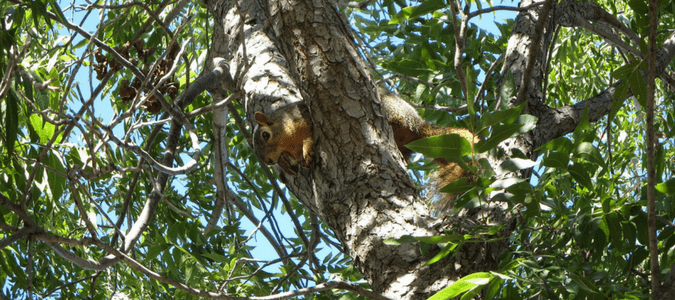
Most Common Trees in Texas
From the live oak trees to the white oaks to the cedar elm trees, the number of tree species in Texas is expansive. And while we could go on to include more, the trees mentioned above, specifically those categorized as native Texas trees, are those more commonly seen around the state.
One important thing to consider when choosing a tree is to ask yourself what you’re looking for in a tree. Are you looking for ample shade, or do you prefer a landscape painted with blooming flowers? Do you mind caring for your trees and flowers, or would you prefer a tree that requires little to no maintenance?
Finally, you’ll also have to take into consideration where you live. You’ll have to determine the type of soil you have in your backyard and understand the weather patterns in your area, as both impact the growth of trees and whether or not they’ll thrive and flourish on your property.
ABC Are Your Tree Experts
Feeling overwhelmed about what trees to add to your landscape? Luckily, ABC Home & Commercial Services are experts at all things tree care and landscape related. We can help you assess your lawn to determine which tree would be the best fit for your desires and abilities. Our team is ready and able to help with whatever you need to ensure your lawn is looking its best, from the moment you decide what your vision is for your yard. Schedule a service today.
